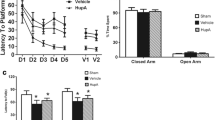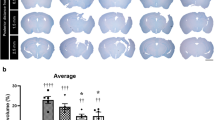Abstract
Objective
To examine the effect of icariin (ICA) on the cognitive impairment induced by traumatic brain injury (TBI) in mice and the underlying mechanisms related to changes in hippocampal acetylation level.
Methods
The modifified free-fall method was used to establish the TBI mouse model. Mice with post-TBI cognitive impairment were randomly divided into 3 groups using the randomised block method (n=7): TBI (vehicle-treated), low-dose (75 mg/kg) and high-dose (150 mg/kg) of ICA groups. An additional sham-operated group (vehicle-treated) was employed. The vehicle or ICA was administrated by gavage for 28 consecutive days. The Morris water maze (MWM) test was conducted. Acetylcholine (ACh) content, mRNA and protein levels of choline acetyltransferase (ChAT), and protein levels of acetylated H3 (Ac-H3) and Ac-H4 were detected in the hippocampus.
Results
Compared with the sham-operated group, the MWM performance, hippocampal ACh content, mRNA and protein levels of ChAT, and protein levels of Ac-H3 and Ac-H4 were signifificantly decreased in the TBI group (P<0.05). High-dose of ICA signifificantly ameliorated the TBI-induced weak MWM performance, increased hippocampal ACh content, and mRNA and protein levels of ChAT, as well as Ac-H3 protein level compared with the TBI group (P<0.05).
Conclusion
ICA improved post-TBI cognitive impairment in mice by enhancing hippocampal acetylation, which improved hippocampal cholinergic function and ultimately improved cognition.
Similar content being viewed by others
References
Ge XT, Lei P, Wang HC, Zhang AL, Han ZL, Chen X, et al. miR-21 improves the neurological outcome after traumatic brain injury in rats. Sci Rep 2014;4:6718.
Drexel M, Puhakka N, Kirchmair E, Hortnagl H, Pitkanen A, Sperk G. Expression of GABA receptor subunits in the hippocampus and thalamus after experimental traumatic brain injury. Neuropharmacology 2015;88:122–133.
Khodaie B, Lotfinia AA, Ahmadi M, Lotfinia M, Jafarian M, Karimzadeh F, et al. Structural and functional effects of social isolation on the hippocampus of rats with traumatic brain injury. Behav Brain Res 2015;278:55–65.
Velazquez R, Ash JA, Powers BE, Kelley CM, Strawderman M, Luscher ZI, et al. Maternal choline supplementation improves spatial learning and adult hippocampal neurogenesis in the Ts65Dn mouse model of down syndrome. Neurobiol Dis 2013;58:92–101.
Uchida H, Fujita Y, Matsueda M, Umeda M, Matsuda S, Kato H, et al. Damage to neurons and oligodendrocytes in the hippocampal CA1 sector after transient focal ischemia in rats. Cell Mol Neurobiol 2010;30:1125–1134.
Huang Y, Shi X, Xu H, Yang H, Chen T, Chen S, et al. Chronic unpredictable stress before pregnancy reduce the expression of brain-derived neurotrophic factor and N-methyl-D-aspartate receptor in hippocampus of offspring rats associated with impairment of memory. Neurochem Res 2010;35:1038–1049.
Casella EM, Thomas TC, Vanino DL, Fellows-Mayle W, Lifshitz J, Card JP, et al. Traumatic brain injury alters longterm hippocampal neuron morphology in juvenile, but not immature, rats. Childs Nerv Syst 2014;30:1333–1342.
Yan BC, Park JH, Kim IH, Shin BN, Ahn JH, Yoo KY, et al. Chronological changes in inflammatory cytokines immunoreactivities in the mouse hippocampus after systemic administration of high dosage of tetanus toxin. Exp Brain Res 2012;223:271–280.
Liu JJ, Li SP, Wang YT. Optimization for quantitative determination of four flavonoids in Epimedium by capillary zone electrophoresis coupled with diode array detection using central composite design. J Chromatogr A 2006;1103:344–349.
Wu J, Du J, Xu C, Le J, Xu Y, Liu B, et al. Icariin attenuates social defeat-induced down-regulation of glucocorticoid receptor in mice. Pharmacol Biochem Behav 2011;98:273–278.
Sze SC, Tong Y, Ng TB, Cheng CL, Cheung HP. Herba epimedii: anti-oxidative properties and its medical implications. Molecules 2010;15:7861–7870.
Wang Z, Zhang X, Wang H, Qi L, Lou Y. Neuroprotective effects of icaritin against beta amyloid-induced neurotoxicity in primary cultured rat neuronal cells via estrogendependent pathway. Neuroscience 2007;145:911–922.
Urano T, Tohda C. Icariin improves memory impairment in Alzheimer's disease model mice (5xFAD) and attenuates amyloid beta-induced neurite atrophy. Phytother Res 2010;24:1658–1663.
Li F, Gong QH, Wu Q, Lu YF, Shi JS. Icariin isolated from Epimedium brevicornum Maxim attenuates learning and memory deficits induced by d-galactose in rats. Pharmacol Biochem Behav 2010;96:301–305.
Kumar S, Herbst B, Strickland D. Experimental biomechanical study of head injuries in lateral falls with skateboard helmet. Biomed Sci Instrum 2012;48:239–245.
Bredy TW, Wu H, Crego C, Zellhoefer J, Sun YE, Barad M. Histone modifications around individual BDNF gene promoters in prefrontal cortex are associated with extinction of conditioned fear. Learn Mem 2007;14:268–276.
Young-Bernier M, Kamil Y, Tremblay F, Davidson PSR. Associations between a neurophysiological marker of central cholinergic activity and cognitive functions in young and older adults. Behav Brain Funct 2012;8:17.
McDonald AJ, Mascagni F, Zaric V. Subpopulations of somatostatin-immunoreactive non-pyramidal neurons in the amygdala and adjacent external capsule project to the basal forebrain: evidence for the existence of GABAergic projection neurons in the cortical nuclei and basolateral nuclear complex. Front Neural Circuit 2012;6:46.
Uchida S, Hotta H, Misawa H, Kawashima K. Sustained subcutaneous infusion of nicotine enhances cholinergic vasodilation in the cerebral cortex induced by stimulation of the nucleus basalis of Meynert in rats. Eur J Pharmacol 2011;654:235–240.
Bentley P, Driver J, Dolan RJ. Cholinergic modulation of cognition: insights from human pharmacological functional neuroimaging. Prog Neurobiol 2011;94:360–388.
Aizawa S, Yamamuro Y. Involvement of histone acetylation in the regulation of choline acetyltransferase gene in NG108-15 neuronal cells. Neurochem Int 2010;56:627–633.
Wang X, Li J, Qian L, Zang XF, Zhang SY, Wang XY, et al. Icariin promotes histone acetylation and attenuates post-stroke cognitive impairment in the central cholinergic circuits of mice. Neuroscience 2013;236:281–288.
Valiyaveettil M, Alamneh YA, Miller SA, Hammamieh R, Arun P, Wang Y, et al. Modulation of cholinergic pathways and inflammatory mediators in blast-induced traumatic brain injury. Chem Biol Interact 2013;203:371–375.
Ostberg A, Virta J, Rinne JO, Oikonen V, Luoto P, Nagren K, et al. Cholinergic dysfunction after traumatic brain injury preliminary findings from a PET study. Neurology 2011;76:1046–1050.
Kelso ML, Wehner JM, Collins AC, ScheffSW, Pauly JR. The pathophysiology of traumatic brain injury in alpha 7 nicotinic cholinergic receptor knockout mice. Brain Res 2006;1083:204–210.
Scremin OU, Norman KM, Roch M, Holschneider DP, Scremin AME. Acetylcholinesterase inhibition interacts with training to reverse spatial learning deficits after cortical impact injury. J Neurotraum 2012;29:2457–2464.
Bennouna M, Greene VB, Defranoux L. Cholinergic hypothesis in psychosis following traumatic brain injury and cholinergic hypothesis in schizophrenia: a link? Encephale 2007;33:616–620.
Zheng M, Qu L, Lou Y. Effects of icariin combined with Panax notoginseng saponins on ischemia reperfusion-induced cognitive impairments related with oxidative stress and CA1 of hippocampal neurons in rat. Phytother Res 2008;22:597–604.
Peleg S, Sananbenesi F, Zovoilis A, Burkhardt S, Bahari-Javan S, Agis-Balboa RC, et al. Altered histone acetylation is associated with age-dependent memory impairment in mice. Science 2010;328:753–756.
Levenson JM, O'Riordan KJ, Brown KD, Trinh MA, Molfese DL, Sweatt JD. Regulation of histone acetylation during memory formation in the hippocampus. J Biol Chem 2004;279:40545–40559.
Wang GH, Jiang XY, Pu HJ, Zhang WT, An CR, Hu XM, et al. Scriptaid, a novel histone deacetylase inhibitor, protects against traumatic brain injury via modulation of PTEN and Akt pathway. Neurotherapeutics 2013;10:124–142.
Dash PK, Orsi SA, Moore AN. Histone deactylase inhibition combined with behavioral therapy enhances learning and memory following traumatic brain injury. Neuroscience 2009;163:1–8.
Fischer A, Sananbenesi F, Mungenast A, Tsai LH. Targeting the correct HDAC(s) to treat cognitive disorders. Trends Pharmacol Sci 2010;31:605–617.
Sharma SK. Protein acetylation in synaptic plasticity and memory. Neurosci Biobehav Reviews 2010;34:1234–1240.
Author information
Authors and Affiliations
Corresponding author
Additional information
Supported by the National Natural Science Foundation of China (No. 81401005), the Natural Science Foundation of Jiangsu Province, China (No. BK20140494), and the University Natural Science Research Major Project of Jiangsu Province, China (No. 16KJA310006)
Rights and permissions
About this article
Cite this article
Zhang, Zg., Wang, X., Zai, Jh. et al. Icariin Improves Cognitive Impairment after Traumatic Brain Injury by Enhancing Hippocampal Acetylation. Chin. J. Integr. Med. 24, 366–371 (2018). https://doi.org/10.1007/s11655-018-2823-z
Received:
Published:
Issue Date:
DOI: https://doi.org/10.1007/s11655-018-2823-z




